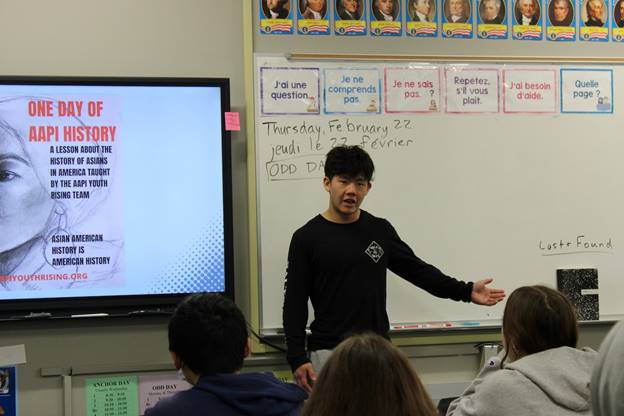
Matthew Sugiyama leads a class on AAPI history for middle school students in the Bay Area - Image courtesy of author
Asian American History Is US History, So Why Don’t Schools Teach It?
By Matthew Sugiyama
Asians are the fastest-growing racial group in the US. Yet most Americans can’t name a famous Asian American or a single event or policy related to them, according to a recent study by The Asian American Foundation.
More than 150 years after the first major wave of Asian immigration to the United States, knowledge of AAPI history across the country is severely lacking and needs to be addressed.
I have the privilege of being a Chapter Leader and Legislative Action Committee lead of the student-led group, AAPI Youth Rising , which works to increase understanding of the AAPI community and combat rising hate and intolerance. Over the last few months, I have presented AAPI Youth Rising’s One Day of AAPI History lesson to several middle school classes.
Thanks to a partnership with the Alliance for a Healthier Generation , the lesson has already reached 52,000 schools across the country, exposing the untold stories of Asians in America.
Still, the last thing I expected when teaching this lesson was to learn a sobering lesson myself. I asked my middle school students to name as many Asian ethnicities as they could. After listening to several enthusiastic responses, one student raised his hand and, with all seriousness, said “Caucasian.” The student genuinely believed it was true.
None of them had heard of the Chinese Exclusion Act or the annexation of Hawaii. The gap in what young people are learning—or not learning—when it comes to AAPI history is shocking, I realized.
Earlier this year, I conducted a survey on AAPI education at my high school in the San Francisco Bay Area. Of the 159 students surveyed, 87% of them did not understand the significance of the murder of Vincent Chin . Chin was an American of Chinese descent who was killed following a racially motivated assault, and his death was a turning point for Asian American civil rights engagement, sparking a movement that challenged systemic injustices and advocated for equality.
My study also showed that 74% of students at my school hadn’t heard of the 442nd Regiment Combat Team, the most decorated military unit in US history. The bravery and sacrifices of the 442nd Regiment made up of Japanese American soldiers during World War II, demonstrated the strength and loyalty of a dedicated group of Japanese Americans whose own country was incarcerating Americans of Japanese descent .
The lack of AAPI recognition in school classrooms speaks directly to the wider underrepresentation of Asian Americans in society and to the recent rise in hate crimes targeting the community.
During the pandemic, we witnessed an alarming increase in anti-Asian sentiment and violence, and the hate incidents continue. According to a 2023 AAPI Data/AP-NORC Center for Public Affairs Research poll of Asian Americans, Native Hawaiians, and Pacific Islanders (AANHPIs), one in three reported experiencing some sort of hate incident in the last year.
Educating young people can help combat the harmful stereotypes fueling this disturbing trend and build a culture of understanding across the nation. It’s a lesson I’ve learned first-hand.
Growing up as an Asian American in a predominantly white community, I experience my share of bullying. Comments like, “Where are you really from?” “You speak English so well” and “You people are so good at math” were also a common refrain. And even if well-intentioned, they have a detrimental impact on youth, leading young Asian Americans like me to feel as though we don’t belong.
Studying AAPI history helped me flip the narrative. It has led to an increased sense of pride in my Asian American culture and a newfound confidence in my own ability to speak about issues facing AAPI youth. That, in turn, has given me the ability to stand up for the AAPI community as a whole.
The good news is that some states are starting to take notice.
In 2021, the Illinois State Board of Education passed the Teaching Equitable Asian American Community History (TEAACH) Act. This ensures that within Illinois public schools, students are taught about Asian Americans’ contributions to the economic, cultural, social, and political development of the US.
Recently, the governor of Wisconsin signed legislation mandating Asian American and Hmong history be taught in all K-12 public schools in the state. Additionally, the New York State Senate has passed a bill requiring the commissioner to establish AANHPI history and civic impact curriculum for school districts.
California is also expected to expand Asian American, Native Hawaiian, and Pacific Islander history in schools. This comes following the passage last year of California Assembly Bill 1354 , introduced by Assemblyman Mike Fong (D-Alhambra), which calls for the creation of curriculum frameworks for Asian American Studies in grades K-12.
These actions can play a vital role in dismantling harmful myths involving the AAPI community, such as the “model minority” and “perpetual foreigner” myths. And they can lead to a broader understanding of Asian Americans’ experiences and acknowledgment of historical discrimination while building a culture of understanding across the nation.
Within the US, only 20 states have mandated the teaching of AAPI History; this is not nearly enough. At a national level, we must collectively fight anti-Asian hate by presenting a more equitable and accurate curriculum to students across America.
AAPI history is part of this country’s history. It’s time to ensure that AAPI history isn’t just a footnote, but an essential part of the narrative we teach future generations.
(Matthew Sugiyama is a Bay Area high school student and Legislative Action Committee Co-Lead with AAPI Youth Rising, - Ethnic Media Services)

